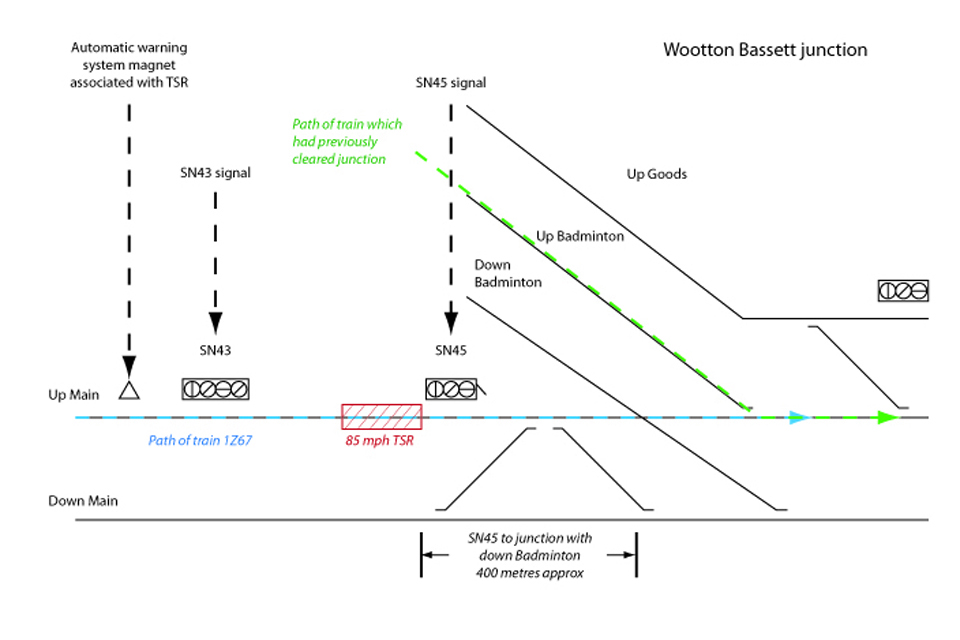Dangerous occurrence at Wootton Bassett junction, Wiltshire
Signal passed at danger (SPAD) on the approach to Wootton Bassett junction, Wiltshire, 7 March 2015.

Wootton Bassett junction in 2012 - the lines shown from left to right are the Up Goods, Up Badminton, Down Badminton, Up Main and Down Main (image courtesy of Network Rail)
RAIB is investigating an incident that occurred at 17:25 hrs on Saturday 7 March 2015, in which train reporting number 1Z67, the 16:35 hrs service from Bristol Temple Meads to Southend, passed a signal at danger on the approach to Wootton Bassett junction, Wiltshire. The train subsequently came to a stand across the junction. The signal was being maintained at danger in order to protect the movement of a previous train. However, at the time that the SPAD occurred, this previous train had already passed through the junction and was continuing on its journey. No injuries, damage or derailment occurred as a result of the SPAD.
Wootton Bassett junction is situated between Chippenham and Swindon stations on the Great Western main line and is the point at which the line from Bristol, via Bath, converges with the line from South Wales. It is a double track high speed junction which also features low speed crossovers between the up and down main lines (see figure below for detail).
The junction is protected from trains approaching on the up main from Chippenham by signal number SN45, which is equipped with both the Automatic Warning System (AWS) and the Train Protection and Warning System (TPWS). This signal is preceded on the up main by signal SN43, which is also equipped with AWS and TPWS. The maximum permitted line speed for trains approaching the junction from this direction is normally 125 mph. However, on 7 March, a temporary speed restriction (TSR) of 85 mph was in place on the approach to signal SN45. A temporary AWS magnet had been placed on the approach to signal SN43 to warn drivers of this TSR.

A diagram of the layout of Wootton Bassett junction - note that some features have been omitted for clarity (not to scale)
The train which passed signal SN45 at danger consisted of steam locomotive number 34067 ‘Tangmere’, and its tender, coupled to 13 coaches. The locomotive is equipped with AWS and TPWS equipment.
The RAIB’s preliminary examination has shown that, at around 17:24 hrs, train 1Z67 was approaching signal SN43 at 59 mph, when it passed over the temporary AWS magnet associated with the TSR. This created both an audible and visual warning in the locomotive’s cab. However, as the driver did not acknowledge this warning within 2.7 seconds, the AWS system on the locomotive automatically applied the train’s brakes. This brake application should have resulted in the train being brought to a stand. In these circumstances, the railway rule book requires that the driver immediately contact the signaller.
The RAIB has found evidence that the driver of 1Z67 did not bring the train to a stand and contact the signaller after experiencing this brake application. Evidence shows that the driver and fireman instead took an action which cancelled the effect of the AWS braking demand after a short period and a reduction in train speed of only around 8 mph. The action taken also had the effect of making subsequent AWS or TPWS brake demands ineffective.
Shortly after passing the AWS magnet for the TSR, the train passed signal SN43, which was at caution. Although the AWS warning associated with this signal was acknowledged by the driver, the speed of the train was not then reduced appropriately on the approach to the next signal, SN45, which was at danger. Because of the earlier actions of the driver and fireman, the TPWS equipment associated with signal SN45 was unable to control the speed of the train on approach to this signal.
As train 1Z67 approached signal SN45, the driver saw that it was at danger and fully applied the train’s brakes. However, by this point there was insufficient distance remaining to bring the train to a stand before it reached the junction beyond SN45. The train subsequently stopped, standing on both the crossovers and the up and down Badminton lines, at around 17:26 hrs. The signalling system had already set the points at the junction in anticipation of the later movement of 1Z67 across it; this meant that no damage was sustained to either the train or the infrastructure as a result of the SPAD.
The RAIB has found no evidence of any malfunction of the signalling, AWS or TPWS equipment involved in the incident.
The RAIB’s investigation will consider the factors that contributed to signal SN45 being passed at danger, including the position of the temporary AWS magnet associated with the TSR. The investigation will also examine the factors that influenced the actions of the train crew, the adequacy of the safety systems installed on the locomotive and the safety management arrangements.
The RAIB’s investigation is independent of any investigation by the Office of Rail Regulation.
We will publish our findings, including any recommendations to improve safety, at the conclusion of our investigation. These findings will be available on the our website.
You can subscribe to automated emails notifying you when we publish our reports and bulletins.